|
|
|
|
The Effect Of Blood Clam Shell Powder Addition On Shear Strength Value Of Clay Soil
Noto Royan 1![]() , R.A. Sri Martini 2
, R.A. Sri Martini 2![]() , Mira Setiawati
3
, Mira Setiawati
3![]() , Revi Yulianti 4
, Revi Yulianti 4
1 Civil
Engineering Study Program, Faculty of Engineering, University of Muhammadiyah
Palembang, Indonesia
|
|
ABSTRACT |
||
|
Ground
condition is an important aspect that influences performance under the load.
An effort to overcome the load problem can be done by improving unstable soil
through soil stabilization using blood clam shell powder. In
order to determine the shear strength and changes in its value, it can
be done by conducting the Triaxial UU test on a mixture of clay and blood
clam shell powder with addition of 10%, 20%, 25%, and 30% of soil weight and
4% coal ash. Mixed soil was then stored in plastic for 24 hours to achieve
evenly distributed moisture content. Laboratory testing was carried out with
reference to ASTM (American Society for Testing and Materials) standards,
aimed to calculate soil shear angle, cohesion, and soil shear strength
values. The results showed that the addition of blood clam shell powder and
coal ash increased the soil shear strength compared to the clay soil (without
any addition). The highest shear strength value of 35,724 kPa was obtained by
adding 25% blood clam shells. |
|||
|
Received 05 December 2022 Accepted 04 January 2023 Published 24 January 2023 Corresponding Author Noto Royan, ir.notoroyan@gmail.com DOI 10.29121/ijetmr.v10.i1.2023.1284 Funding: This research
received no specific grant from any funding agency in the public, commercial,
or not-for-profit sectors. Copyright: © 2023 The
Author(s). This work is licensed under a Creative Commons
Attribution 4.0 International License. With the
license CC-BY, authors retain the copyright, allowing anyone to download,
reuse, re-print, modify, distribute, and/or copy their contribution. The work
must be properly attributed to its author.
|
|||
|
Keywords: Ash from
Burning Bricks, Shear Strength, Blood Shells, Stability, Clay Soil |
|||
1. INTRODUCTION
High bearing capacity subgrade is a highly expected factor in structural planning because the structure strength will be directly affected by its ability to receive and transmit the load from the structure above it. In this study, soil stabilization was carried out using the chemical stabilization method with additional materials used for stabilization, namely blood clam shell powder (Anadaragranosa) and coal ash. Previous study carried out by Aziudin (2019) utilized blood clam shells with addition of 0%, 10%, 15%, 20%, 25%, and 30% of the weight of the expansive clay which was then applied to shallow foundations. The unconfined compression test showed that the addition of 25% blood clam shell powder increased the value of the free compressive strength (qu) to the maximum point of 3,434 kg/cm2. The research topic was soil stabilization test with blood clam shells adding 10%, 20%, 25%, and 30% of the soil weight and 4% coal ash which was then stored for 24 hours to achieve evenly distributed moisture content. Followed by the Triaxial Act (Unconsolidated Undrained) test American Society For Testing and Materials. (1999). Optimizing the utilization of shells and coal ash are expected to reduce waste and provide added value. This study aimed to perceive the effect of adding blood clam shell powder and coal ash to increase clay soil stability in terms of the Triaxial UU (Unconsolidated Undrained) test American Society for Testing and Materials. (2010c), and determine the best percentage of blood clam shell and coal ash as a stabilizer either to increase clay soil stability to get the highest soil shear strength value or to achieve the optimum stability value of clay.
2. Methodology
2.1. Preparation
1) Soil
Sampling
The clay samples used were taken from Tanjung Aur III Housing Area on Tanjung Barangan Street, Bukit Baru Village, Ilir Barat I District, Palembang City, South Sumatra. The grain size of the soil was 4.75mm (passed sieve No.4).
2) Blood
Clam Shell Sampling
Blood clam shells (Anadaragranosa) were the waste of the PecelLele& Seafood Apollo restaurant on Jenderal Basuki Rachmat Street, Pahlawan, Kemuning District, Palembang City, South Sumatra.
3) Coal
Ash Sampling
Coal ash was obtained from a brick kiln in Celikah Village, Raya Simpang Kijang Street, KijangUlu, KayuAgung District, Ogan KomeringIlir Regency, South Sumatra.
2.2. Test Items Production
1) The clay samples used as a test object were dried under the sun. The tests carried out were:
· Soil physical properties assessment include soil moisture content, Atterberg limits of plastic limit and liquid limit, and Specific gravity evaluation.
· Soil mechanical properties assessment include Triaxial UU (Unconsolidated Undrained) test.
2) The cleaned blood clam shells were roasted for approximately 1 hour, then pounded with a pounder to produce powder and sieved using a No. sieve. 40 (0.425 mm).
3) Coal ash taken from the brick kiln was sieved using a No. sieve. 200 (0.075 mm).
4) Soil passed filter No. 4 was mixed with powdered shells, coal ash and distilled moisture.
5) Mixed test object was put into a plastic bag and then stored for 24 hours to achieve evenly distributed moisture content.
6) The
amount of blood clam shell and coal ash was obtained from substituting the
total amount of clay required for the Triaxial UU experiment according to the
percentage of blood clam shell added and planned. Table 1
Table 1
|
Table 1 Shellfish Powder Addition |
||||
|
Shell Variation |
Shell Weight |
Ash Variation |
Ash Weight |
Clay Soil Weight |
|
0% |
0 |
0% |
0 |
2000 gr |
|
0% |
0 |
4% |
80 gr |
1920 gr |
|
10% |
200 gr |
4% |
80 gr |
1720 gr |
|
20% |
400 gr |
4% |
80 gr |
1520 gr |
|
25% |
500 gr |
4% |
80 gr |
1420 gr |
|
30% |
600 gr |
4% |
80 gr |
1320 gr |
2.3. Soil Properties Index Assessment. American Society for Testing and Materials, (2010d)
· Moisture content test (ASTM D2216: 2010).
· Filter analysis test (ASTM D6913-04: 2009).
· Atterberg limit test, Liquid limit (LL) (ASTM D4318-08: 2010).
· Specific gravity (Gs) test (ASTM D854-10: 2010).
2.4. Soil Mechanical Properties Assessment
· American Society for Testing and Materials, (2010d)
· Soil compaction test (Standard proctor) (ASTM D698-12:2010)
· Unconsolidated Undrained Triaxial Testing (ASTM D2850-95: 1999)
3. Results and Discussion
3.1. Assessment of Physical Properties (Index Properties) and Mechanical Properties of Soil (Mechanical Properties)
Evaluation of soil index properties was carried out to
identify the soil. Soil index properties obtained were soil parameter values
including moisture content, sieve analysis, Atterberg limits (liquid limit and
plastic limit), and specific gravity. Mechanical properties of the clay soil
were evaluated using soil compaction test (standard proctor) and Triaxial UU
(Unconsolidated Undrained) American Society for Testing and
Materials. (2010d). Table 2
Table 2
|
Table 2 Index Properties, Mechanical Properties, and Classification of Clay Soil |
||
|
No |
Soil Identifications |
Results |
|
1 |
moisture Content (%) |
41,67 |
|
2 |
Sieve Analysis |
|
|
Passed through Sieve (%) |
||
|
No. 4 |
99,020 |
|
|
No. 10 |
96,120 |
|
|
No. 20 |
92,498 |
|
|
No. 40 |
88,416 |
|
|
No. 60 |
83,820 |
|
|
No. 80 |
78,544 |
|
|
No. 100 |
71,620 |
|
|
No. 200 |
54,306 |
|
|
3 |
Atterberg Limits |
|
|
Liquid Limit (%) |
57,24 |
|
|
Plastic Limit (%) |
28,63 |
|
|
4 |
Specific Gravity (Gs) |
2,662 |
|
5 |
Soil classification according to USCS |
OH |
|
6 |
Soil classification according to AASHTO |
A-7-6 |
|
7 |
Optimum moisture Content ( |
28522% |
|
8 |
Maximum dry density ( |
1,419 gr/cm3 |
|
9 |
Cohesion (c) |
25,7 kPa |
|
10 |
Angle of Internal Friction (ϕ) |
18,91° |
3.2. Results of Mixed Soil Assessment
1)
The
Effect of Mixed Soil on the Value of Moisture Content
The average moisture content of clay soil was 41.67%. Meanwhile, moisture content of mixed soil with the addition of 10% - 30% shell powder and 4% coal ash and stored for 24 hours afterward tended to decrease. A significant decrease in moisture content occurred at the addition of 25% shell powder, while the addition of 30% shell powder increased moisture content. Table 3, Figure 1.
|
Table 3 Moisture Content |
|
|
Mixed Variations |
Soil Moisture Content (%) |
|
Clay Soil |
27.43 |
|
Soil + 4% ash |
27.09 |
|
Soil + 10% shell + 4% ash |
26.43 |
|
Soil + 20% shell + 4% ash |
25.64 |
|
Soil + 25% shell + 4% ash |
26.15 |
Figure 1

|
Figure 1 Graphic of Moisture Content |
2)
The
Effect of Mixed Soil on the Liquid Limit Value
The addition of blood clam shell powder and 4% ash decreased liquid limit value. A significant decrease in the liquid limit value occurred with the addition of 20% blood clam shell powder. Meanwhile, at the addition of 25% and 30% blood clam shell powder, the liquid limit value constantly increased. Table 4, Figure 2
|
Table 4 Liquid Limit Test |
|
|
Mixed Variations |
Liquid Limit Value (%) |
|
Clay Soil |
57.24 |
|
Soil + 4% ash |
55.96 |
|
Soil + 10% shell + 4% ash |
53.08 |
|
Soil + 20% shell + 4% ash |
52.03 |
|
Soil + 25% shell + 4% ash |
52.88 |
|
Soil + 30% shell + 4% ash |
53.15 |
Figure 2

|
Figure 2 Graphic of Mixed Soil Liquid Limit |
3)
The
Effect of Mixed Soil on the Plastic Limit Value
The addition of blood clam shell powder and 4% coal ash increased plastic limit value. The plastic limit value increased significantly at the addition of 20% shell powder. Table 5, Figure 3.
Table 5
|
Table 5 Mixed Soil Plastic Limit Test |
|
|
Mixed Variations |
Plastic Limit Value (%) |
|
Clay Soil |
28.63 |
|
Soil + 4% ash |
29.73 |
|
Soil + 10% shell + 4% ash |
31.33 |
|
Soil + 20% shell + 4% ash |
32.92 |
|
Soil + 25% shell + 4% ash |
30.80 |
|
Soil + 30% shell + 4% ash |
29.68 |
Figure 3

|
Figure 3 Graphic of Mixed Soil Plastic Limit Value |
4) The
Effect of Mixed Soil on the Plasticity Index (IP)
Table 6
|
Table 6 Mixed Soil Plasticity Index |
|
|
Mixed
Variations |
Plastic
Index (%) |
|
Clay
Soil |
28.61 |
|
Soil +
4% ash |
26.23 |
|
Soil +
10% shell + 4% ash |
21.75 |
|
Soil +
20% shell + 4% ash |
19.11 |
|
Soil +
25% shell + 4% ash |
22.08 |
|
Soil +
30% shell + 4% ash |
23.47 |
Figure 4
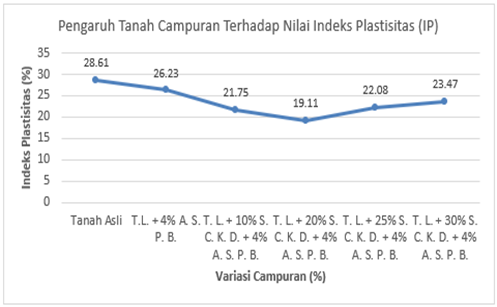
|
Figure 4 Graphic of Mixed Soil Plasticity Index |
5) Effect of Mixed Soil on Specific Gravity
|
Table 7 Mixed Soil Specific Gravity (Gs) |
|
|
Mixed
Variations |
Plastic
Limit Value (Gs) |
|
Clay
Soil |
2.662 |
|
Soil +
4% ash |
2.629 |
|
Soil +
10% shell + 4% ash |
2.642 |
|
Soil +
20% shell + 4% ash |
2.615 |
|
Soil +
25% shell + 4% ash |
2.583 |
|
Soil +
30% shell + 4% ash |
2.607 |
Figure 5

|
Figure 5 Graphic of Mixed Soil Specific Gravity |
The addition of blood clam shell powder and 4% coal ash constantly decreased specific gravity values. The addition of 30% blood clam shell powder did not significantly increase the specific gravity.
6)
Effect
of Mixed Soil on Cohesion Value (c)
and Angle of Internal Friction (ϕ)
Table 8
|
Table 8 Cohesion and Angle of Internal Friction of Mixed Soil |
||
|
Mixed
Variations |
Cohesion,
c (kPa) |
Soil
Shear Angleϕ (°) |
|
Clay Soil |
25.70 |
18.91 |
|
Soil + 4% ash |
28.40 |
18.94 |
|
Soil + 10% shell + 4% ash |
30.30 |
22.07 |
|
Soil + 20% shell + 4% ash |
32.20 |
23.36 |
|
Soil + 25% shell + 4% ash |
35.70 |
25.52 |
|
Soil + 30% shell + 4% ash |
31.90 |
22.09 |
Figure 6
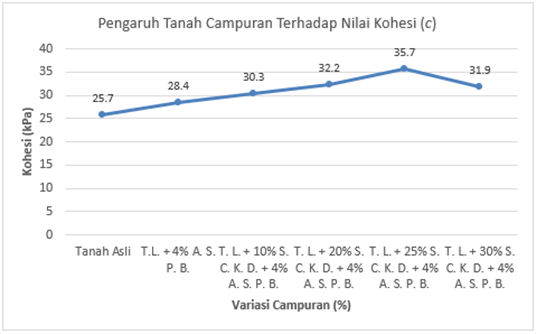
|
Figure 6 Graphic of Mixed Soil Cohesion Value |
The addition of blood clam shell powder and 4% coal ash increased cohesion value. Increased value occurred relatively constant following the amount of blood clam shell powder and coal ash added. The highest cohesion value was obtained by the addition of 25% blood clam shell powder of 35.70 kPa. Meanwhile, the addition of 30% blood clam shell powder decreased cohesion value. Figure 7
Figure 7
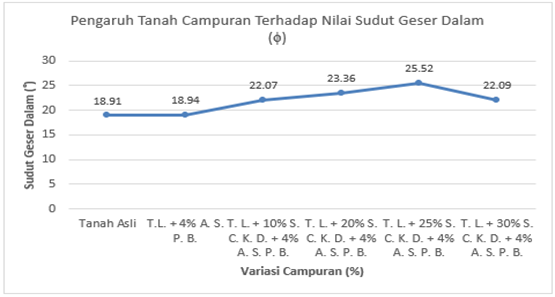
|
Figure 7 Graphic of Mixed Soil Angle of Internal Friction |
The addition of blood clam shells significantly increased the angle of internal friction. It can be seen that the clay soil angle of internal friction value was 18.91°, while highest angle of internal friction of 25.52° was obtained by adding 25% blood clam shell powder.
The shear strength of clay can be calculated using the
Coulomb equation Hardiyatmo (1992).
Figure
8
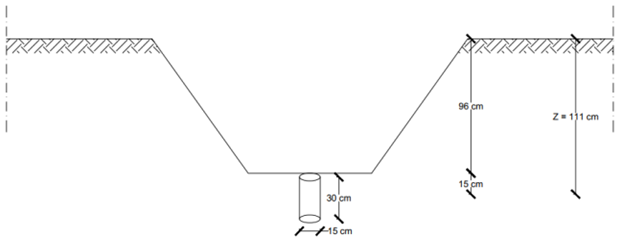
|
Figure 8 Sketch of Soil Sampling on Site |
The clay sample at the sampling sites was taken at a depth of 1.1 meters from the soil surface, for the depth Z used in this shear strength calculation, the depth of soil extraction was added to half of the tube height. Table 9, Figure 9.
|
Table 9 Recapitulation of Mixed Soil Shear Strength (τ) |
|
|
Mixed
Variation |
Shear
Strength, τ (kPa) |
|
Clay Soil |
25.716 |
|
Soil + 4% ash |
28.422 |
|
Soil + 10% shell + 4% ash |
30.323 |
|
Soil + 20% shell + 4% ash |
32.224 |
|
Soil + 25% shell + 4% ash |
35.724 |
|
Soil + 30% shell + 4% ash |
31.923 |
Figure 9
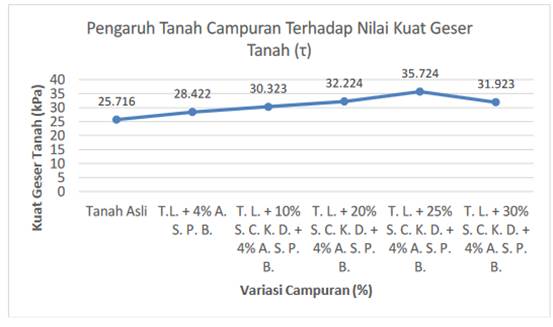
|
Figure 9 Graphic of Mixed Soil Shear Strength |
4. Conclusion
1)
Triaxial UU test obtained the cohesion value (c)
of 25.716 kPa and the shear angle (ϕ) of 18.91º from clay soil without the
addition of blood clam shell powder and coal ash. The addition of 25% blood
clam shell powder increased the cohesion value and the shear angle to maximum
points of 35.70 kPa and 25.52º, respectively.
2) The highest shear strength of 35,724 kPa was obtained by the addition of 25% blood clam shell powder.
CONFLICT OF INTERESTS
None.
ACKNOWLEDGMENTS
None.
REFERENCES
Afranita, G., Anita, S., and Hanifah, T. A. (2014). Potensi abu CangkangKerangDarah (AnadaraGranosa) SebagaiAdsorben Ion TimahPutih. Jurnal Universitas Riau, 1(1), 1–5.
American Society For Testing and Materials. (1999). Standard Test Method For Unconsolidated-Undrained Triaxial Compression Test of Cohesive Soil. ASTM Designation, D2850–D2895.
American Society for Testing and Materials. (2009). Standard Test Methods For Particle-Size Distribution (Gradation) of Soils Using Sieve Analysis. ASTM Designation, D6913–D6904.
American Society for Testing and Materials. (2010a). Standard Test Methods For Laboratory Compaction Characteristics of Soil Using Standard Effort (12.400 Ft-Lbf/Ft3 (600 Kn-M/M3)). ASTM Designation, D698–D612.
American Society for Testing and Materials. (2010b). Standard Test Methods for Laboratory Determination of moisture (Moisture) Content of Soil and Rock by Mass. ASTM Designation, D2216–D2210.
American Society for Testing and Materials. (2010c). Standard Test Methods for Liquid Limit, Plastic Limit, And Plasticity Index of Soils. ASTM Designation, D4318–D4308.
American Society for Testing and Materials. (2010d). Standard Test Methods for Specific Gravity of Soil Solids By Water Pycnometer. ASTM Designation, D854–D810.
Atterberg, A. (1911). Uber Die Physikalisebodenuntersuchung Und Uber Die Plastizitatder Tone, Int Mitt, 1. Boden.
Aziudin, H. (2019). Pengaruh Penambahan Serbuk Cangkang Kerang Untuk Meningkatkan Stabilitas Lempung Ekspansif Terhadap Daya Dukung Pondasi Dangkal. Jurnal Universitasnegeri Surabaya, 2(1), 1–9.
Bowles, J. E. (1984). Sifat-Sifat Fisisdan Geoteknis Tanah (Mekanika Tanah) Edisi I. Erlangga.
Bowles, J. E. (1991). Sifat-Sifat Fisisdan Geoteknis Tanah (Mekanika Tanah) Jilid II. Erlangga.
Chen, F. H. (1975). Foundations on Expansive Soils. Elsevier.
Das, B. M. (1995). Mekanika Tanah (Prinsip-Prinsiprekayasageoteknis) Jilid 1. Erlangga.
Hardiyatmo, H. C. (1992). Mekanika tanah 1. PT. Gramedia Pustaka Utama.
Hardiyatmo, H. C. (2002). Mekanika Tanah I. Gadjahmada University Press.
Ingles, O. G., and Metcalf, J. B. (1972). Soil Stabilization: Principles and Practice. Butterworths.
Ismida, Y., and Bahri, S. (2015). Pengaruh Campuran Limbah Cangkang Kerang Terhadap Daya Dukung Tanah. Jurnal Ilmiah JURUTERA, 2(1), 1–9.
Lambe, T. W., and Whitman, R. V. (1979). Soil Mechanics. John Wiley And Sons, Inc.
Mohr. (1910). Geotechnical Engineering Investigation Manual. Mcgraw-Hill Book, Co.
Setyowati, M., and Chairudin. (2016). Kajian Limbah Cangkang Kerang Sebagai Alternatif Bahan Amelioran Di Lahangambut. Jurnal Agrotek Lestari, 2(1), 59–64.
Siregar, S. M. (2009). Pemanfaatan Kulit Kerang Dan Resin Epoksi Terhadap Karakteristik Beton Polimer. Universitas Sumatera Utara.
Terzaghi, K., and Peck, R. (1987). Mekanika Tanah Dalampraktekrekayasajilid I. Erlangga.
Wesley, L. D. (1977). Mekanika Tanah (IV). Badan Penerbit Pekerjaan Umum.
|
|
 This work is licensed under a: Creative Commons Attribution 4.0 International License
This work is licensed under a: Creative Commons Attribution 4.0 International License
© IJETMR 2014-2023. All Rights Reserved.


